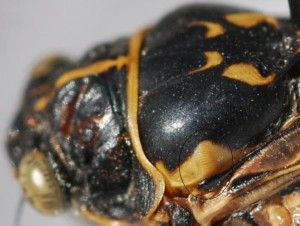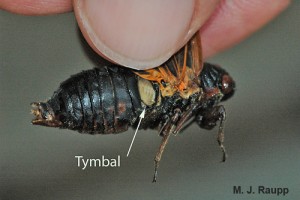Cicada Acoustic Communication
To communicate between and within their species, insects have evolved various ways to produce sound. Sound communication can play an important role in reproduction and sexual selection. In various cicada species, sound production informs mating behavior through male acoustic advertisement and female acoustic response that expresses their reproductive availability. The male tymbal organs and the female stridulatory organs facilitate these interactions. Tymbal organs are thin membranes on the side of the cicada’s body, near the first abdomen segment (Fig. 1; Capinera 2008). By changing the position of their abdomens through vertical movements, cicadas can produce three to four chirps. The tymbal organs increase the amplitude and radiation of these sounds (Cong Wei 2015). In contrast, the female cicadas produce sounds through wing fluttering and their stridulatory organs. Stridulatory organs consist of a striated area called a file and a scraper that is usually part of a large vein under cicada wings (Fig. 2; Capinera 2008). The quick up and down movement of the cicada forewings creates and upward and downward chip, as well an impact sound when the wings move back to their resting position (Cong Wei 2015).

Fig. 2. Striated file of cicada stridulatory organ; http://www.cicadamania.com/cicadas/a-third-way-cicadas-make-sounds/
Crossing Boundaries: Subpsaltria yangi Sexual Mimicry
The Subpsaltria yangi, an endemic Chinese cicada species, represents an example of the evolution of sound production in the context of mating behavior. Unlike other cicada species, S. yangi males possess tymbal organs and stridulatory organs, while female S. yangi still only possess stridulatory organs. Cong Wei studied the S. yangi to clarify the purpose and significance of this adaptation in male sound production organs, which currently lacks data and research. Since most other male cicada species do not possess stridulatory organs, Cong Wei, hypothesized this adaptation could serve as an example of sexual mimicry or transvetism within species. In other words, the male cicada species takes on the acoustic behavior of the female species to elicit a better and quicker response from female cicadas who perceive male sexual mimicry as rival females.
The results of Cong Wei’s study revealed the acoustic structure of female and male Subpsaltria yangi sound signals and the reproductive interactions associated with this acoustic communication. Males produce two types of sounds for intraspecific sexual communication by using their tymbal and stridulatory mechanisms. The use of both tymbal and stridulatory mechanism elicited the greatest amount and degree of sound responses in females. Females responded to a lesser amount and degree to the use of only the tymbal organs and did not respond to only the male stridulatory mechanism. Additionally, male cicadas alternated between the use of their tymbal organs and stridulatory organs in a manner that mimicked an interaction between a male and female. In terms of the female response, it was discovered that females produce sounds via their stridulatory organs exclusively in the context of pair formation. Finally, the comparison of the acoustic structures between male and female stridulatory sounds showed no significant difference in terms of their frequency and duration. The similarity in calls was further supported when males responded to other males stridulatory and tymbal signals.
In the context of pair formation for S. yangi, the sexual interactions occur with male advertisement and female response, similar to many other cicada species. Since the females only produced stridulatory sounds in the context of pair formation, it is assumed this signal carries information important to reproduction, like sex, receptive state, and location. Extreme similarities between the male and female stridulatory sounds indicate the possibility of male sexual mimicry. Since females preferentially responded to the male use of both acoustic mechanisms, it is sexually advantageous for males to mimic female stridulatory sounds, in addition to their own sexual signal. The alternating pattern between stridulatory and tymbal sound production fabricates a scenario of a male and female sexually communicating with one another. This can lead a perceiving female to believe there is a potential mate, but also a rival female. Therefore, the perceiving female become a more active signaler and increases her amplitude to express her attractiveness and to compete with the rival female. Males, consequently, benefit from their intraspecific female mimicry because it elicits a more effective female response and decreases the amount of time looking for a mate, which exposes him to predation risk. According to the results of this study, sexual mimicry in S. yangi serves as a successful mechanism to gain reproductive benefit over other males.
Acoustic Sexual Mimicry in Cicadas—the Rarity
No previous reports reveal another cicada species that contains males who possess and use both tymbal and stridulatory organs in reproductive communication. The results of this study expand our knowledge about the diversity of insect sound producing behaviors. Furthermore, this study provides information about the use of stridulatory mechanisms for sound production in cicadas and represents a rare example of intraspecific sexual mimicry based on acoustic similarity.
References
Capinera, J.L (Ed.). (2008) Encyclopedia of Entomology (2nd ed.) New York: Springer Publishing Company.
Cong Wei, C.L. (2015) Intraspecific sexual mimicry for finding females in a cicada: males produce ‘female sounds’ to gain reproductive benefit. Animal Behavior, 102, 69-76.

